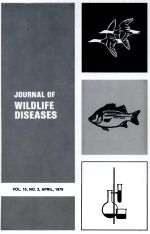Fluoroacetamide (1081 or F.A.A.) is used in Israel for field rodent control. Experiments on direct and secondary, short and long term poisoning caused by 1081 were carried out. Mongoose (Herpestes ichneumon), hyena (Hyaena hyaena), cats and dogs were susceptible. Barn owls (Tyto alba), buzzards (Buteo buteo) and black kites (Milvus m. migrans) were markedly resistant. Barn owls tolerated total direct poisoning ranging from 6.8 to 10.9, and a final dose ranging from 0.8 to 2.0 mg/kg. In secondary poisoning, total doses ranging from 1.7 to 7.1, and final doses ranging from 0.2 to 1.3 mg/kg were tolerated. Buzzards tolerated total direct poisoning ranging from 6 to 12.0, and final doses ranging from 0.7 to 1.3 mg/kg. In secondary poisoning, doses ranging from 0.8 to 10.3 and final doses ranging from 0.2 to 2.4 mg/kg were tolerated. One black kite tolerated a total direct dose of 6.1 and final dose of 0.7 mg/kg, another survived a total dose of 2.3 and final dose of 0.2 mg/kg in secondary poisoning. A small-scale secondary poisoning experiment on two Palestine vipers (Vipera palestinae), a Syrian black snake (Coluber jugularis) and two Montpellier snakes (Malpolon monspessulanus) indicated that these species were resistant to total doses ranging from 0.1 to 3.2 and final doses of 0.1 to 0.8 mg/kg.
How to translate text using browser tools
1 April 1979
EXPERIMENTS ON DIRECT AND SECONDARY POISONING BY FLUOROACETAMIDE (1081) IN WILDLIFE AND DOMESTIC CARNIVORES
YEHUDA BRAVERMAN





